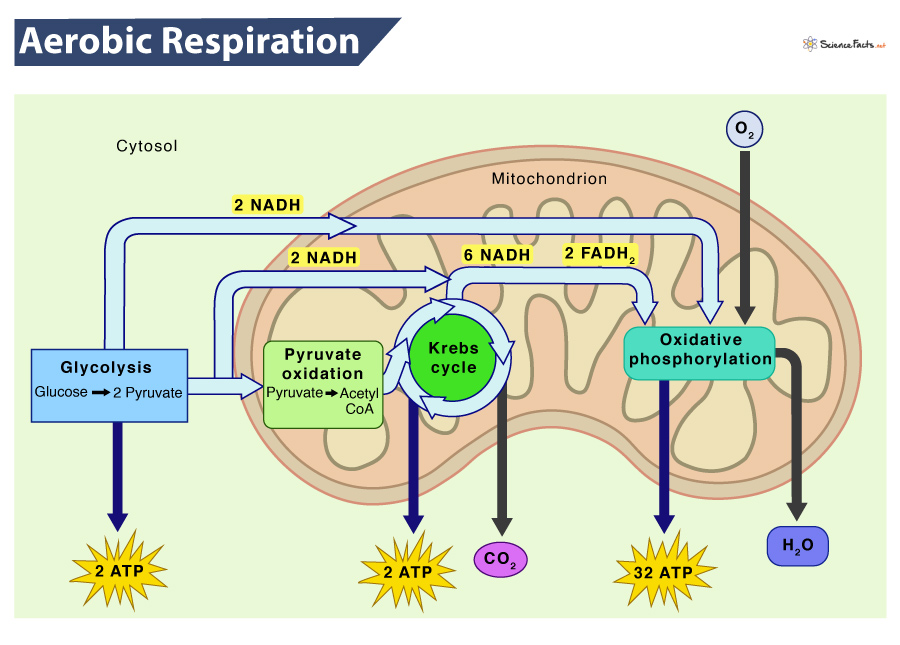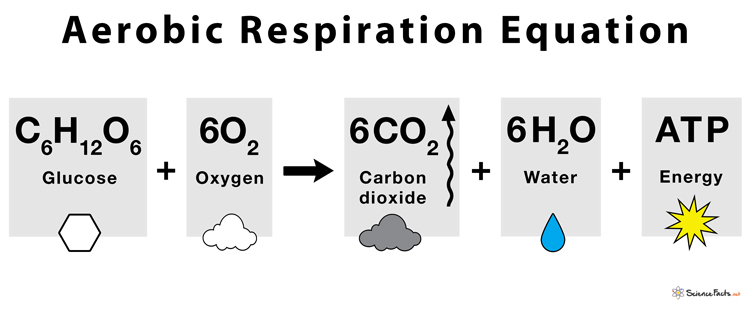Aerobic Respiration
All living beings require energy to perform various life activities, and they gain this energy through cellular respiration. Based on the availability of oxygen, organisms undergo two types of respiration: aerobic and anaerobic. When the cell gets a sufficient supply of oxygen, it undergoes aerobic respiration, otherwise it performs anaerobic respiration.
What is Aerobic Respiration
Aerobic respiration is a form of cellular respiration in which glucose gets broken down in the presence of oxygen, releasing its stored biochemical energy in the form of adenosine triphosphate (ATP).
Word equation
Glucose + Oxygen → Carbon dioxide + Water + Energy
Balanced chemical equation
C6H12O6 + 6O2 → 6CO2 + 6H2O + Energy (as ATP)
Reactants/Raw materials
1. Glucose (C6H12O6)
2. Oxygen (O2)
End/Final products
1. Carbon dioxide (CO2)
2. Water (H2O)
3. Energy (as ATP)
Waste products
1. Carbon dioxide (CO2)
2. Water (H2O)
Example
- Respiration in all multicellular organisms like birds, animals, insects, humans, and plants
- Respiration in aerobic bacteria
When and Where Does Aerobic Respiration Occur
As mentioned, during aerobic respiration, when the cell gets an adequate supply of oxygen, the glucose molecule undergoes complete oxidation, releasing maximum energy.
The process of aerobic respiration starts in the cell cytoplasm. However, a major portion of it takes place in the mitochondria, as all the enzymes required for the later processes are present there. So, mitochondria are considered as the main site of aerobic respiration.
Steps of Aerobic Respiration
Aerobic cellular respiration involves three major stages: glycolysis, citric acid cycle, and oxidative phosphorylation. In between glycolysis and citric acid cycle, there is a transition or linking reaction, pyruvate oxidation.
1. Glycolysis
It is the first phase of aerobic respiration, occurring in the cell cytoplasm. In this 10-step biochemical pathway, a glucose molecule gets converted into 2 pyruvates, which are 3-carbon molecules. Though 4 ATPs are produced in this process, 2 of them are utilized in this phase only. So, in the end, there is a net gain of 2 ATPs, while 2NAD+ changes to 2NADH.
2. Pyruvate oxidation
The 2 pyruvates from the previous step enter the mitochondrial matrix, where they get oxidized to acetyl-CoA by the action of pyruvate dehydrogenase complex (PDC). During this process, one molecule of NADH and CO2 is generated for the conversion of each pyruvate.
3. Citric Acid Cycle/ Krebs cycle
In this stage, the acetyl CoA combines with a four-carbon molecule oxaloacetate, producing citric acid through a cycle of reactions. The cycle runs once for each pyruvate. So, it runs twice as 2 pyruvate molecules were derived in the first step. Each cycle yields 2 molecules of carbon dioxide, 1 molecule of ATP, 3NADH and 1FADH2. At the end of two cycles, the net gain is 2ATP, 6NADH, and 2FADH2.
4. Oxidative phosphorylation
In this step, the NADH and FADH2 made in the previous phases get transformed into NAD+ and FAD, respectively, by donating their electrons in the electron transport chain (ETC). As electrons move down the chain, they move from a higher to a lower energy level, releasing energy. This energy is captured as a proton gradient, which is then used to make ATP in a process called chemiosmosis. Together, the electron transport chain (ETC) and chemiosmosis make up oxidative phosphorylation.
This released energy is used to pump protons out of the matrix into the intermembrane space, forming an electrochemical gradient. Next, the protons flow back into the matrix through an enzyme called ATP synthase, making ATP. At the end of ETC, the oxygen accepts electrons and takes up protons, forming water.
Note: Out of the steps mentioned above, only glycolysis can take place without oxygen. The other three stages of cellular respiration—pyruvate oxidation, the citric acid cycle, and oxidative phosphorylation require oxygen to occur.
How many ATP molecules are produced in aerobic respiration?
Theoretically, aerobic respiration yields 38 ATPs from one glucose molecule. However, some of them are lost during the active transportation of pyruvate, phosphate, and ADP from the cytoplasm to mitochondria within the process itself.
Here’s an overall estimate of ATP production:
Efficiency of ATP production
| Name of the step | No. of ATP produced |
|---|---|
| Glycolysis | 2 |
| Krebs cycle | 2 |
| Electron transport chain | 32 |
| ∴ Total energy yield | 36 |
Function
Aerobic respiration supplies fuel for the repair, growth, and maintenance of cells. Though the process is long and slow, its main advantage is that it undergoes complete oxidation of glucose, liberating the most energy possible for the survival of life.
Summary
- Cellular respiration is of two types: aerobic and anaerobic.
- During aerobic respiration, glucose gets broken down in the presence of oxygen.
- It involves four stages: glycolysis, pyruvate oxidation, Krebs cycle, and oxidative phosphorylation.
- During aerobic respiration, electrons travel downhill in the following sequence: glucose → NADH → electron transport chain → oxygen.
- In aerobic respiration, chemiosmotic generation of ATP is driven by the difference in H+ or proton concentration on the two sides of the inner mitochondrial membrane.
FAQs
Ans. Oxygen is the final electron acceptor in aerobic respiration.
Ans. In aerobic respiration, oxygen helps in the complete oxidation of glucose molecules.
Ans. Both alcohol fermentation and aerobic respiration have glycolysis as their initial step.
Ans. No stage of aerobic respiration requires CO2.
Ans. Atmospheric oxygen is the source of oxygen for aerobic respiration.
-
References
Article was last reviewed on Friday, February 17, 2023





